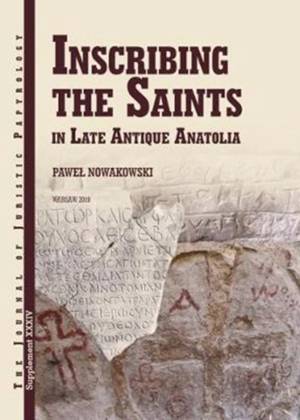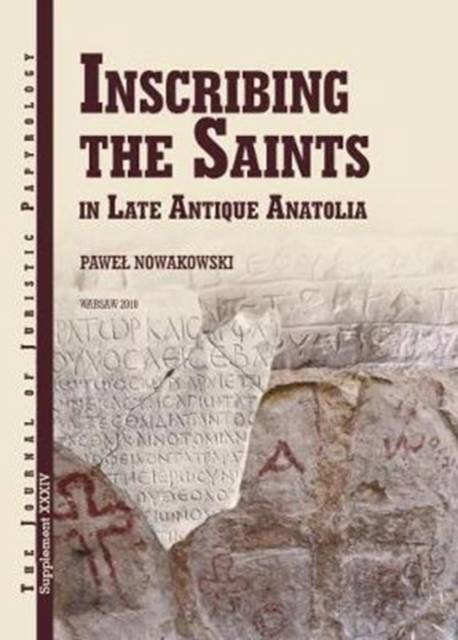
- Afhalen na 1 uur in een winkel met voorraad
- Gratis thuislevering in België vanaf € 30
- Ruim aanbod met 7 miljoen producten
- Afhalen na 1 uur in een winkel met voorraad
- Gratis thuislevering in België vanaf € 30
- Ruim aanbod met 7 miljoen producten
Zoeken
Omschrijving
The book explores the use of inscriptions as an instrument of the cult of saints in Asia Minor between the 4th and mid-7th c. AD. In addition to the analytical chapters, the work encompasses a catalogue of around 250 inscriptions on stone, mosaics, small objects (in particular reliquaries), and graffiti, attesting to the rise and development of the cult of saints in the discussed region and period. For the first time such a catalogue includes revised full texts of inscriptions, English translations, bibliographical references, and a detailed commentary.
The book was awarded the 2018 EKVAM Annual Award of the Ancient Anatolian Studies by the Izmir Center of the Archaeology of Western Anatolia. The analytical part is divided into five chapters preceded by an introduction which discusses methodological issues, presents a short history of research on the epigraphy of the cult of saints in Asia Minor, and the possibility of the application of the principles of 'the epigraphic habit theory' into the studies on the cult of saints.
Chapter 1 shows different categories of inscriptions used in the religious practice: epitaphs for martyrs, inscriptions commemorating translations of relics, labels of reliquaries, inscribed invocations of saints, building and dedicatory inscriptions, vows, inscriptions using names of saints as a marker of identity, inscriptions attesting burials ad sanctos, inscriptions from boundary stones, inscriptions recording normative and liturgical texts, and others.
Chapter 2 deals with the chronological distribution of the evidence collected. The saints chosen as addresses of their prayers and vows by the commissioners of inscriptions, and the saintly epithets, are closely discussed respectively in Chapter 3 and Chapter 4.
A prosopographical overview of the commissioners of inscriptions is presented in Chapter 5. This chapter also includes considerations on the motivation of donors recording their deeds by the means of inscriptions, with particular emphasis put onto the transition from the 'rational' to the 'emotional' motivation and the phenomenon of 'the longing for the saint'. The geographical distribution of all the sources collected, and of sources illustrating cults of selected saints is shown on maps.
The book was awarded the 2018 EKVAM Annual Award of the Ancient Anatolian Studies by the Izmir Center of the Archaeology of Western Anatolia. The analytical part is divided into five chapters preceded by an introduction which discusses methodological issues, presents a short history of research on the epigraphy of the cult of saints in Asia Minor, and the possibility of the application of the principles of 'the epigraphic habit theory' into the studies on the cult of saints.
Chapter 1 shows different categories of inscriptions used in the religious practice: epitaphs for martyrs, inscriptions commemorating translations of relics, labels of reliquaries, inscribed invocations of saints, building and dedicatory inscriptions, vows, inscriptions using names of saints as a marker of identity, inscriptions attesting burials ad sanctos, inscriptions from boundary stones, inscriptions recording normative and liturgical texts, and others.
Chapter 2 deals with the chronological distribution of the evidence collected. The saints chosen as addresses of their prayers and vows by the commissioners of inscriptions, and the saintly epithets, are closely discussed respectively in Chapter 3 and Chapter 4.
A prosopographical overview of the commissioners of inscriptions is presented in Chapter 5. This chapter also includes considerations on the motivation of donors recording their deeds by the means of inscriptions, with particular emphasis put onto the transition from the 'rational' to the 'emotional' motivation and the phenomenon of 'the longing for the saint'. The geographical distribution of all the sources collected, and of sources illustrating cults of selected saints is shown on maps.
Specificaties
Betrokkenen
- Auteur(s):
- Uitgeverij:
Inhoud
- Aantal bladzijden:
- 400
- Taal:
- Engels
- Reeks:
- Reeksnummer:
- nr. 34
Eigenschappen
- Productcode (EAN):
- 9788394684846
- Verschijningsdatum:
- 10/11/2018
- Uitvoering:
- Hardcover
- Formaat:
- Genaaid
- Afmetingen:
- 152 mm x 279 mm
- Gewicht:
- 1886 g

Alleen bij Standaard Boekhandel
+ 210 punten op je klantenkaart van Standaard Boekhandel
Beoordelingen
We publiceren alleen reviews die voldoen aan de voorwaarden voor reviews. Bekijk onze voorwaarden voor reviews.











